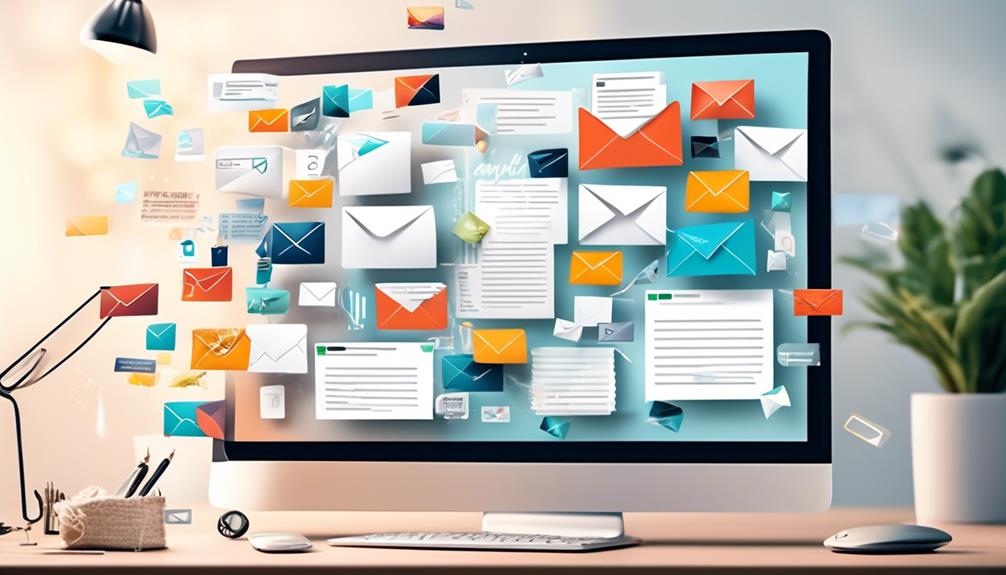Email marketing is a powerful and widely-used strategy that has revolutionized the world of marketing. It is a form of direct and digital marketing that has proven to be highly effective.
But what exactly does it entail? And what are the various types that exist within this realm?
Let’s embark on an exploration of the ins and outs of email marketing and discover the diverse types that can be wielded to captivate and convert audiences.
Key Takeaways
- Email marketing allows businesses to engage with potential customers through personalized communication.
- Different types of emails, such as welcome, promotional, and abandoned cart emails, serve specific purposes in driving sales and conversions.
- Building an effective email list through opt-ins and avoiding purchased email lists is crucial for successful email marketing campaigns.
- While email marketing has advantages like forcing action, building relationships, and allowing for personalized messages, it also has disadvantages such as spam filters, slow loading times, and device compatibility issues.
Email Marketing Basics
Engaging with potential customers through personalized email communication is a fundamental aspect of email marketing basics. It involves understanding the different types of emails, such as welcome emails, promotional emails, and abandoned cart emails, and how they fit into marketing campaigns. Building an effective email list is crucial for reaching customers genuinely interested in the products or services offered. It’s essential to avoid purchasing email lists and instead focus on encouraging opt-ins through website forms, incentives, and engaging content.
Creating compelling and targeted content is key to connecting with customers and maximizing the impact of email marketing. Welcome emails are the first point of contact with new subscribers and should make a positive impression. Promotional emails aim to drive sales and conversions, while abandoned cart emails can help recover potential lost sales. Understanding the diverse purposes of these emails enables marketers to tailor their campaigns effectively.
Advantages and Disadvantages

Email marketing offers numerous advantages and disadvantages that businesses need to consider when developing their marketing strategies.
Advantages:
- Forcing Action: Email compels users to take action, whether it’s reading, deleting, or archiving the email.
- Relationship Building: It helps build relationships with the audience and directs traffic to blogs or social media, nurturing leads.
- Personalization: Segmentation allows for more personalized messages, targeting users by demographics for higher open rates.
- Testing and Optimization: A/B testing of subject lines and calls to action helps identify the best-performing messages for effective email campaigns.
Disadvantages:
- Spam Filters: Spam emails often get ignored or filtered into junk folders, affecting the success of email marketing campaigns.
- File Sizes and Loading Times: Large email file sizes can lead to slow loading times, causing potential customers to lose interest.
- Competition and Engagement: Email marketing faces strong competition, requiring exceptional copywriting and promotions to stand out, with continuous engagement efforts to avoid unopened rates or unsubscribes.
- Device Compatibility: Email design variation across devices can result in a less than ideal user experience and potential deletion, impacting the success of transactional emails.
Types of Email Campaigns
Discussing the various types of email campaigns allows businesses to tailor their marketing efforts to specific customer needs and behaviors.
Inbound email marketing campaigns focus on providing valuable and relevant content to attract and engage customers. These emails aim to build a strong relationship with the audience by offering insights, tips, and educational content.
Recurring email campaigns, such as newsletters or product updates, are sent on a regular schedule to maintain customer engagement and keep them informed about the latest products or services.
Onboarding campaigns are designed to guide new subscribers or customers through their initial experience with a brand or product, helping them get acquainted with the offerings and features.
Drip campaigns involve sending a series of automated, targeted emails based on specific triggers or actions taken by the customer, nurturing leads and guiding them through the sales funnel.
Seasonal campaigns are strategically planned around holidays or specific seasons to promote offers or events related to those periods, leveraging the seasonal interest and purchasing behavior of customers.
Each type of email campaign serves different purposes in email marketing, contributing to lead generation, customer engagement, and product promotion.
Inbound Vs Outbound Marketing

After exploring the various types of email campaigns, it becomes essential to differentiate between inbound and outbound marketing strategies in order to understand their distinct approaches to customer engagement and lead generation.
- Approach: Inbound marketing focuses on attracting potential customers through valuable content and experiences, while outbound marketing involves reaching out to potential customers through traditional advertising methods.
- Engagement: In inbound marketing, businesses create and share valuable content to attract and engage prospects, while in outbound marketing, businesses initiate the conversation and send messages out to potential customers.
- Objective: Inbound marketing aims to provide value and build relationships with potential customers, whereas outbound marketing aims to deliver messages to a wide audience to generate leads and sales.
- Strategies: Inbound marketing strategies include content marketing, social media marketing, and search engine optimization, while outbound marketing strategies include cold calling, direct mail, and traditional advertising.
Understanding the distinction between inbound and outbound marketing is crucial for email marketing. Whether it’s lead nurturing for existing customers or capturing the attention of a target audience, the approach taken greatly influences the effectiveness of marketing emails.
As a marketing manager, choosing the right form of direct marketing, whether through a series of emails for inbound marketing or a compelling call to action for outbound marketing, is pivotal for achieving the desired results.
Email Marketing Examples
Exploring a variety of email marketing examples provides valuable insights into effective strategies for customer engagement and lead generation. Here are some examples of different types of marketing emails used by businesses:
| Type of Email | Description | Example |
|---|---|---|
| Welcome emails | Sent to new subscribers to build a relationship and set expectations. | A new product launch welcome email from a company to potential customers. |
| Promotional emails | Offer specific deals or promotions to drive sales and revenue. | An email newsletter from a retailer with special discounts for subscribers. |
| Re-engagement emails | Designed to reconnect with inactive subscribers and can be cost-effective for businesses. | A special offer email from a company to re-engage inactive subscribers. |
These examples showcase the versatility of email marketing and the potential impact on customer engagement and lead nurturing. As a marketing manager at Digital, I’ve found that using email marketing software to craft effective email newsletters has been instrumental in reaching our audience and driving conversions. By sending marketing emails that are tailored to different customer segments, we’ve been able to effectively promote new products, gather feedback, and re-engage potential customers.
Frequently Asked Questions
What Are the 4 Types of Email Marketing?
We’ll cover the four types of email marketing:
- Welcome emails set the tone, making a positive first impression.
- Newsletters provide regular updates to keep customers informed and engaged.
- Promotional emails offer discounts and product information to drive sales.
- Transactional emails give essential information, such as order confirmations or shipping notifications.
Each type serves a specific purpose and plays a crucial role in engaging and retaining customers.
What Is Email Marketing With Example?
Email marketing involves utilizing email to promote products, engage customers, and build relationships. An example is Farnam Street’s Brain Food newsletter, offering valuable content to subscribers. It’s a powerful tool for lead generation and brand awareness.
We use it to segment customers, create relevant content, and grow our contact list. This maximizes engagement and response rates, making it an essential part of our marketing strategy.
What Are the 7 Email Marketing Strategies?
We’ve mastered the art of email marketing with these 7 strategies:
- Captivating welcome emails
- Informative newsletters
- Compelling dedicated emails
- Persuasive promotional emails
- Revenue-boosting abandoned cart emails
- Engaging re-engagement emails
- Effective post-purchase emails
These strategies ignite customer engagement, drive sales, and enhance brand loyalty.
Our expertise in these proven tactics will elevate your email marketing game and drive impressive results for your business.
What Is Email Marketing Best Defined As?
We define email marketing as a powerful digital strategy for promoting products or services. It enables direct communication with our target audience and plays a crucial role in generating leads, building brand awareness, and fostering customer engagement.
Leveraging various types of marketing emails, such as promotional, survey, and transactional, allows us to tailor our approach to different purposes and segments. This flexibility and direct connection with recipients make email marketing a valuable tool in our marketing arsenal.
Conclusion
In conclusion, email marketing is like a digital Swiss Army knife, with different types of campaigns serving various purposes like a masterful chef’s array of tools.
From the sizzle of promotional emails to the subtle nudge of abandoned cart emails, it’s a versatile strategy that can build relationships, generate leads, and boost brand awareness.
So, next time you hit send on an email campaign, remember that you’re wielding a powerful tool in the digital marketing world.










